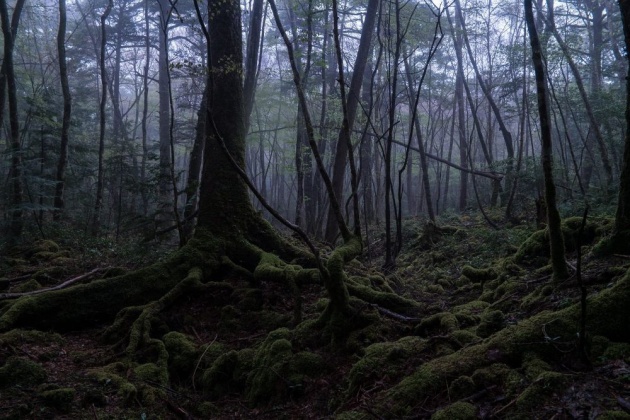Aokigahara (青木ヶ原?), also known as the Suicide Forest or Sea of Trees (樹海 Jukai?), is a 35-square-kilometre (14 sq mi)forest that lies at Mount Fuji's northwest base in Japan.
The forest contains a large number of rocky icy caverns, a few of which are popular tourist destinations. Aokigahara forest is very dense, shutting out all but the natural sounds of the forest itself.[1] The forest has a historic association with "yūrei" or angry ghosts of the dead in Japanese mythology, and it is a notoriously common suicide site (in which 54 took place in 2010).[2] For this reason, a sign at the head of the main trail urges suicidal visitors to think of their families and contact asuicide prevention association.[3]

Geography
The forest floor consists primarily of volcanic rock and is difficult to penetrate with hand tools such as picks or shovels. The forest itself is very dense, and one can get lost easily if leaving the official trails. Because of this, in recent years, hikers and tourists trekking through Aokigahara have begun to use plastic tape to mark their paths so as to avoid getting lost.[4] Past the designated trails leading to tourist attractions such as the Ice Cave and Wind Cave, the first kilometer of the forest is littered with tape and other rubbish left by tourists, despite officials' attempts to remove it. After the first kilometer into Aokigahara towards Mount Fuji within the Fuji-Hakone-Izu National Park, the forest is in better condition, with little to no litter and few obvious signs of human presence
Suicides
The forest is reportedly the most popular site for suicide in Japan and among the top three most popular sites for suicide in the world. Statistics vary, but there were around 30 suicides documented every year during the period leading up to 1988.[5]
In 2003, 105 bodies were found in the forest, exceeding the previous record of 78 in 2002.[6] In 2010, it was estimated that more than 200 people had attempted suicide in the forest, of whom 54 completed the act.[2] Suicides are said to increase during March, the end of the fiscal year in Japan.[7] As of 2011, the most common means of suicide in the forest were hanging or drug overdose.[8] In recent years, local officials have stopped publicizing the numbers in an attempt to downplay Aokigahara's association with suicide.[9]
The high rate of suicide has led officials to place a sign at the forest's entry, written in Japanese, urging suicidal visitors to seek help and not take their own lives. Annual body searches have been conducted by police, volunteers, and attendant journalists since 1970.[10][11][12]
The site's popularity has been attributed to Seichō Matsumoto's 1960 novel Kuroi Jukai (Black Sea of Trees).[13] However, the history of suicide in Aokigahara predates the novel's publication, and the place has long been associated with death: ubasute may have been practiced there into the nineteenth century, and the forest is reputedly haunted by the yūrei (angry spirits) of those left to die
Anime and manga
In the anime series Mazinger Z, Professor Juzo Kabuto's laboratory is set right next to Aokigahara, and he lives not too far from there with his grandsons Koji and Shiro.
In the anime series Transformers: Super-God Masterforce, the location of the Cybertrons' main base is in Aokigahara.
In the second season of Yowamushi Pedal, the first half of Day 3 of the 41st Inter High takes place on Route 139, and passes through the Fuji Five Lakes and Aokigahara
In the anime and manga series The Kurosagi Corpse Delivery Service, the central characters meet and discover their various supernatural talents while taking part in a Buddhist voluntary project to find and remove the bodies of people who have killed themselves in the forest.
In the anime series Samurai Deeper Kyo, Demon-eyes Kyo's former body is hidden in Aokigahara, referred to as the "Sea of Trees" in the anime.
Films
Forest of the Living Dead (2010), also known outside of the United States as The Forest, depicts the enacted vengeance of a jilted covergirl who supernaturally transforms into a demonic spirit when she kills herself in Aokigahara Jukai.
In the movie Grave Halloween (2013), a young woman journeys to Aokigahara with friends to find the body of her biological mother (who committed suicide there) and save her mother's restless spirit. A video camera documents harrowing and deadly paranormal events in the forest.
In the movie 47 Ronin (2013), a half-breed servant named Kai (played by Keanu Reeves), servant to a provincial lord, was left to die in the Aokigahara forest as a child by his mother, where he is found by a race of demons. They raise him to manhood and teach him their supernatural ways of killing.
In the movie The Sea of Trees (2015), directed by Gus Van Sant, an American man (played by Matthew McConaughey) travels to Aokigahara to kill himself and meets a Japanese man (played by Ken Watanabe) who has same thoughts.
In the film The Forest (2016), a woman (played by Natalie Dormer) travels to a ghost-filled Aokigahara to save her twin sister (also played by Dormer).
In the film The People Garden, directed by Nadia Litz, a Canadian woman travels to Japan and discovers her boyfriend has gone missing in the forest and is presumed dead.
Games
In the fighting game Akatsuki Blitzkampf, the protagonist Akatsuki's stage is set in the bank of Lake Sai and the beginning of Aokigahara.
Mount Hikami, the setting of the Wii U video game Fatal Frame: Maiden of Black Water, is based on Aokigahara.
Literature
Kuroi Jukai (Black Sea of Trees) by Seichō Matsumoto is a novel that refers to the popularity of the forest as a suicide spot.
The Three by Sarah Lotz features Aokigahara as a place where several characters perished, either in plane crashes or by choice.
Suicide Forest by Jeremy Bates is a horror novel that takes place inside the forest.
The Sea of Trees (pub. 1997) by Yannick Murphy is a novel about a young girl detained in an isolation camp during World War II.
Music
The album The Sea of Trees (2015) by Secret Grief is named after the forest and includes a track called "Aokigahara".[citation needed]
Japanese metal band Dir En Grey includes an artist rendering of the forest on the cover of its album Dum Spiro Spero.
The Album "Aokigahara" by Austrian Black Metal band Harakiri for the Sky was named after the forest.
The song "Kuroi Ledge" (2013) by post-hardcore outfit A Lot Like Birds makes reference to the book named after the forest
The album "Aokigahara Online" by Floridian vaporwave artist of the same name, in a play on words between America Online and Aokigahara
The Japanese noise collective "Shroud of vapour" recorded three sessions in the forest, two of which appear on the album Suicide Forest Sessions.
In a song by the VOCALOID producer Neru, Yasashii Hito ni Naritai / I Want to Become a Kind Person, one of the lines translates to online games, the famous sea of trees, bullying, aphorism.
The song "Sea of Trees" (2013) by American Black Metal band Esoteric Burial depicts a psychometric paranormal event taking place in the forest and deals with the concept of internal struggle relative to the human experience.
References
Zack Davisson. "The Suicide Woods of Mt. Fuji". Seek Japan.
^ Jump up to: a b Gilhooly, Rob (26 June 2011). "Inside Japan's 'Suicide Forest'". Japan Times. p. 7.
Jump up ^ Brennan, Lyle (10 April 2012). "The suicide forest of Japan: Mount Fuji beauty spot where up to 100 bodies are found every year". Daily Mail. Associated Newspapers. Retrieved 2012-04-10.
Jump up ^ "Intruders tangle 'suicide forest' with tape". Asahi Shimbun. 2008-05-03. Archived from the original on 2008-05-06. Retrieved 2008-05-03.
Jump up ^ Takahashi, Yoshitomo (1988). "EJ383602 - Aokigahara-jukai: Suicide and Amnesia in Mt. Fuji's Black Forest". Education Resources Information Center (ERIC). Retrieved September 20, 2008.
Jump up ^ "Aokigahara forest". February 14, 2014.
Jump up ^ Lah, Kyung (March 19, 2009). "Desperate Japanese head to 'suicide forest'". CNN.com. Asia. Retrieved April 10, 2012. 'Especially in March, the end of the fiscal year, more suicidal people will come here because of the bad economy,' he said. 'It's my dream to stop suicides in this forest, but to be honest, it would be difficult to prevent all the cases here.'
Jump up ^ ROB GILHOOLY, Special to The Japan Times (June 26, 2011). "SUNDAY TIMEOUT: Inside Japan's 'Suicide Forest'". Japan Times. Retrieved July 29, 2012.
^ Jump up to: a b "Suicide Forest". Studio 360 (Japan). January 8, 2010. Retrieved February 11, 2010.
Jump up ^ "Japan's harvest of 69 death". The Independent (London). October 24, 2000. Archived from the original on 24 April 2008. Retrieved May 3, 2008.
Jump up ^ Hadfield, Peter (June 16, 2001). "Japan struggles with 69 soaring death toll in Suicide Forest". The Sunday Telegraph (London).
Jump up ^ "Kyodo News: 'Suicide forest' helps skew Yamanashi's statistics". Japan Times. May 9, 2012. p. 3.
Jump up ^ 波の塔〈下〉(文春文庫): 松本 清張: 本 (in Japanese). Tōkyō: Bungeishunjū. 2009. ISBN 978-4167697235. Retrieved 11 January 2011.



